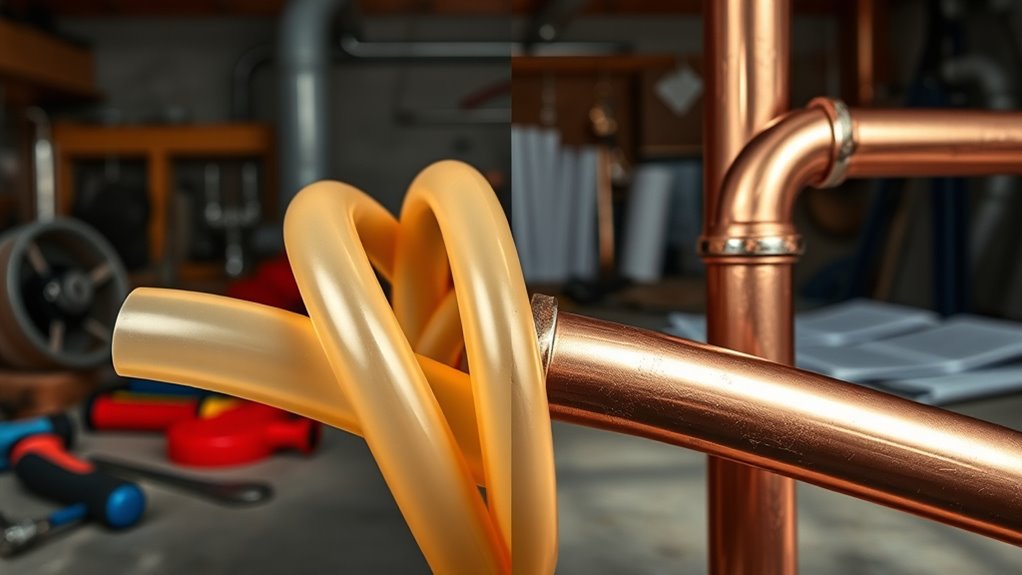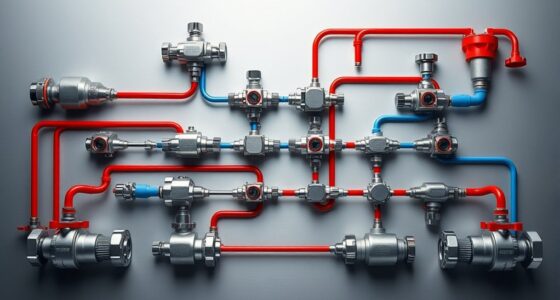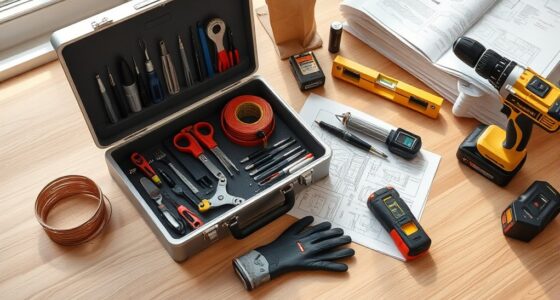To avoid mistakes with PEX vs. copper piping, focus on more than just upfront costs and ease of installation. Consider long-term expenses, climate impacts, and local codes to guarantee your system lasts and remains compliant. Make sure materials are compatible with your existing setup and that you understand installation requirements. Don’t overlook maintenance needs or the importance of quality over price. Staying mindful of these key factors helps you make smarter choices—so keep exploring for more expert insights.
Key Takeaways
- Consider long-term costs and durability, not just initial prices, to avoid future repair expenses.
- Check local building codes and regulations to ensure material compliance and prevent delays or rework.
- Assess environmental factors like temperature fluctuations and UV exposure that impact pipe longevity.
- Verify compatibility with existing plumbing systems and pressure ratings to prevent leaks and system failures.
- Factor in installation complexity and maintenance needs to ensure reliable, sustainable plumbing solutions.
Overlooking Budget and Long-Term Costs
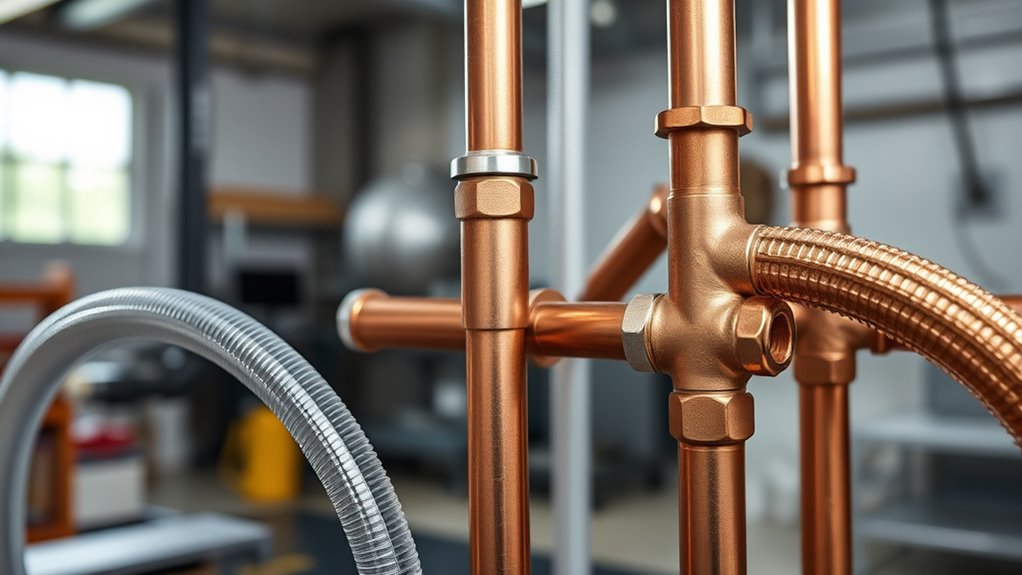
Many beginners focus only on the upfront costs of PEX and copper piping without considering long-term expenses. This oversight can lead to budget planning mistakes that affect your finances over time. PEX piping is typically cheaper initially, but it may require more frequent replacements or repairs, increasing long-term expenses. Copper pipes cost more upfront but tend to last longer with minimal maintenance. When comparing these options, you should evaluate not just immediate costs but also durability, installation, and potential future repairs. Ignoring these factors can cause budget surprises later. Additionally, understanding the material properties of each piping type can help you make more informed decisions. To make the best decision, consider both short-term affordability and the impact on your long-term expenses. A clear understanding of these aspects guarantees your plumbing investment remains cost-effective over the years.
Ignoring Climate and Environmental Conditions
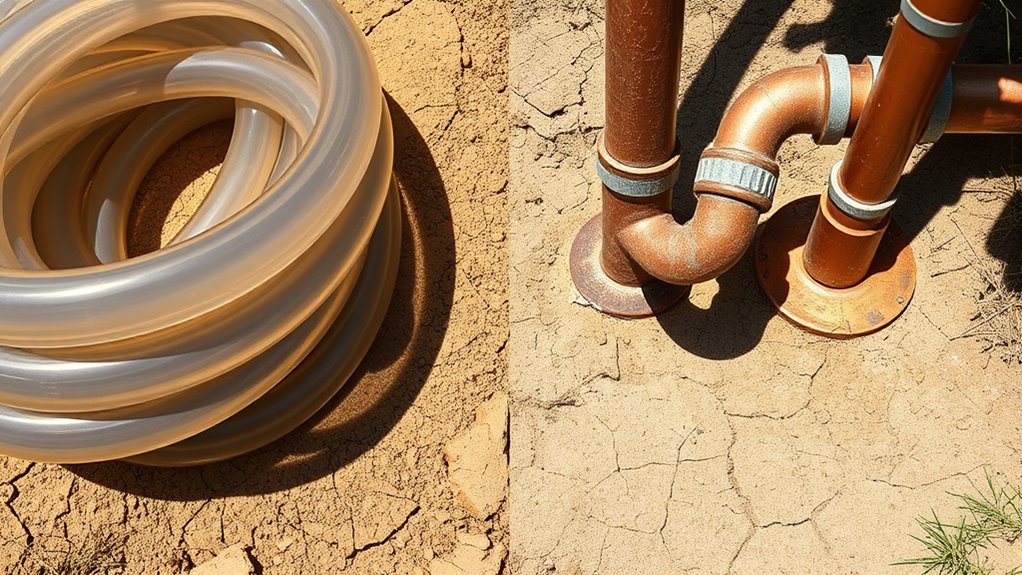
You need to contemplate how your climate affects your piping choice, as some materials handle temperature fluctuations better than others. Environmental exposure can also impact durability, especially in areas prone to corrosion or extreme weather. Make sure your installation complies with regional codes that address these environmental factors to avoid future issues. Incorporating environmental considerations into your planning can significantly enhance the longevity and performance of your piping system.
Climate Impact on Materials
Ignoring climate and environmental conditions can lead to crucial mistakes when choosing between PEX and copper piping. For example, UV exposure affects UV resistance, causing PEX to degrade if left outdoors without protection. Temperature variations impact thermal expansion, which is more pronounced in copper, risking leaks or damage in fluctuating climates. Wind, moisture, and soil chemistry also influence durability.
Consider these factors:
- UV resistance: PEX may need shielding outdoors.
- Thermal expansion: Copper expands more, requiring careful installation.
- Temperature extremes: Copper handles high heat better, but expands considerably.
- Environmental exposure: Corrosive environments weaken copper faster.
Understanding these climate impacts ensures you select the right material for longevity and performance.
Environmental Durability Concerns
Environmental factors beyond climate, such as soil chemistry, moisture levels, and exposure to corrosive elements, considerably influence the durability of PEX and copper piping. PEX pipes generally have good chemical stability, but they can degrade if exposed to certain chemicals or UV rays over time, which highlights the importance of UV resistance. Copper pipes are inherently more resistant to many environmental elements, but they can corrode if the soil chemistry is highly acidic or contains aggressive minerals. Ignoring these factors can lead to premature failures. To guarantee longevity, consider the specific environmental conditions of your installation site. Proper protective measures, such as UV-resistant coatings for PEX or suitable pipe bedding, are critical to maintaining the integrity of your plumbing system in challenging environments. Additionally, understanding corrosion resistance can help you choose the most durable material for your specific environmental conditions.
Regional Code Compliance
Regional plumbing codes are essential to guarantee your installation meets safety and quality standards, but these regulations often vary considerably between areas. Ignoring your local regional code can lead to violations, delays, or costly rework. To ensure compliance, consider these key points:
- Always check the regional code before choosing PEX or copper, as some areas restrict certain materials.
- Understand specific plumbing standards related to pipe installation, support, and durability.
- Verify if there are restrictions based on environmental factors, even if not explicitly climate-related.
- Consult local inspectors or authorities to clarify ambiguities in the regional code.
Failing to Consider Local Building Codes and Regulations
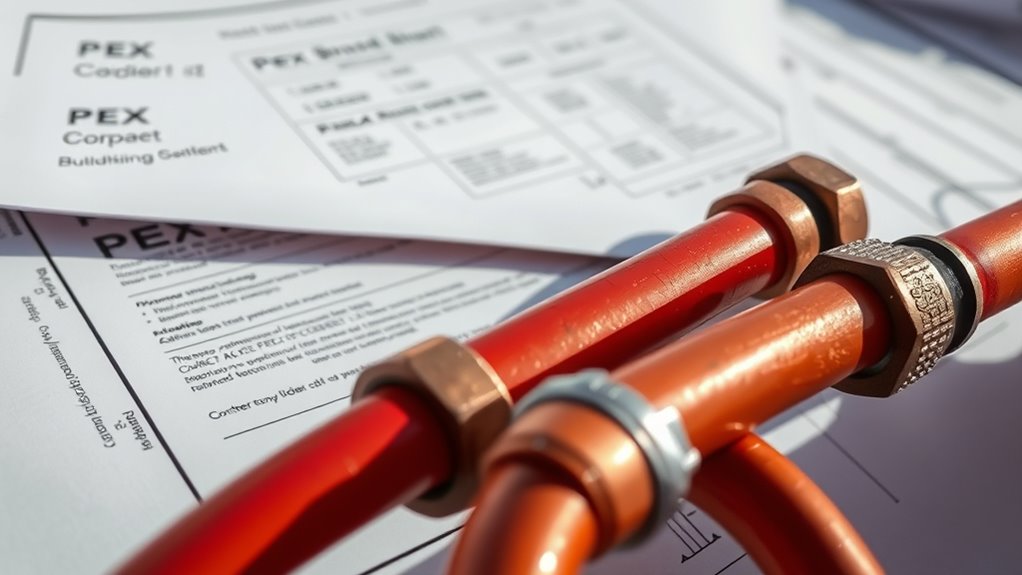
Before starting your plumbing project, it’s essential to understand that local building codes and regulations can vary considerably and must be followed carefully. These codes often specify acceptable pipe joint techniques, ensuring safety and durability. Ignoring them can lead to costly modifications or violations. Additionally, some regulations may restrict material color options or require specific markings for identification. Failing to check these requirements might cause delays or non-compliance issues during inspections. Take time to research your local codes and consult with authorities if needed. Doing so helps you select the right materials and installation methods, whether using PEX or copper, and ensures your project adheres to all legal standards. Being diligent upfront saves you trouble down the line. Also, understanding the applicable regulations related to water safety and environmental impact can further help you make compliant and sustainable choices.
Neglecting Compatibility With Existing Plumbing Systems
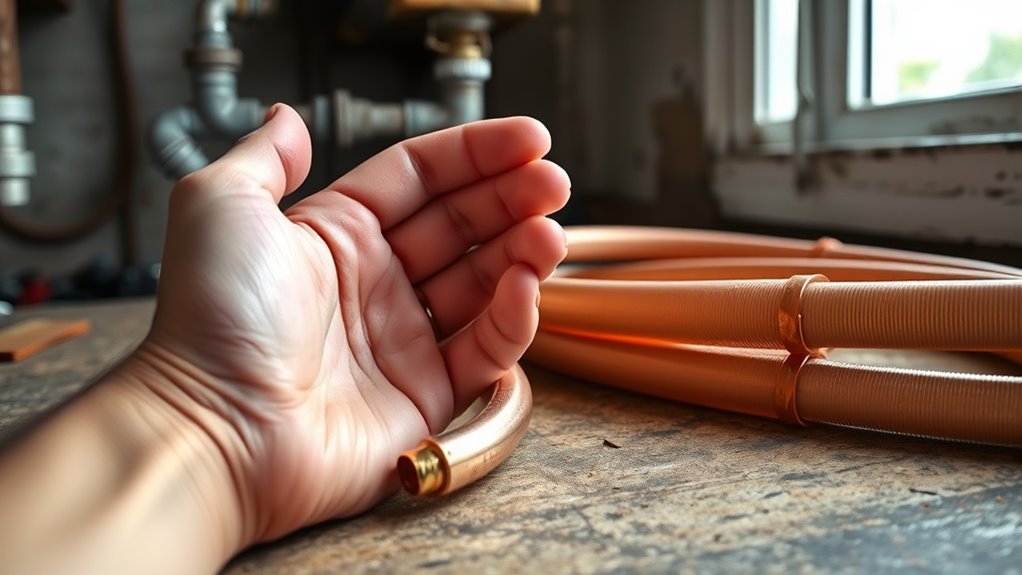
You need to check if your new piping material works with your current system, especially the existing pipe materials and pressure levels. Using incompatible materials or ignoring pressure ratings can cause leaks or failures down the line. Always verify that your chosen pipes match your system’s requirements before installing. Additionally, understanding the signs of spoilage in your water or juice can help prevent health issues caused by contaminated liquids.
Existing Pipe Materials
Failing to contemplate the compatibility of PEX or copper pipes with your existing plumbing system can lead to costly problems down the line. You need to consider the current pipe materials to ensure proper integration. Ignoring this can cause issues like pipe corrosion, reduced material lifespan, or leaks. Additionally, understanding the emotional support needs of family members during plumbing upgrades can help ease stress and foster cooperation throughout the project.
System Pressure Compatibility
When upgrading your plumbing with PEX or copper pipes, it’s important to make certain your system can handle the existing pressure levels. Check the pressure ratings of both materials to ensure they match your system’s requirements. Copper pipes typically handle higher pressure ratings, making them suitable for older systems with greater pressure demands. PEX, on the other hand, often has lower pressure ratings, so you need to confirm that your existing system’s pressure won’t exceed its limits. Material compatibility also plays a role; some plumbing setups may not work well with certain pipe types due to pressure constraints. Failing to consider pressure ratings and material compatibility can lead to leaks or failures down the line. Always verify that your system’s pressure levels align with the specifications of your chosen pipe material. Additionally, understanding system pressure compatibility is crucial to prevent potential damage and ensure long-term reliability.
Underestimating Installation Complexity and Skill Requirements
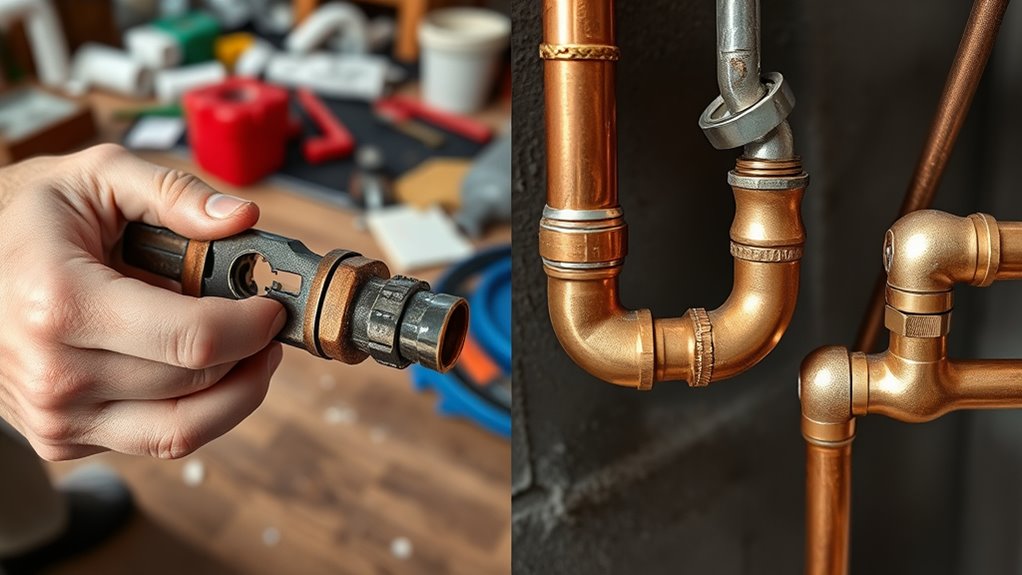
Many beginners underestimate just how challenging installing PEX or copper piping can be, often assuming it’s a straightforward task. The truth is, mastering installation techniques requires skill development and experience. If you overlook this, you risk poor connections or leaks. To avoid mistakes, consider these points:
- Properly learning and practicing installation techniques before starting.
- Recognizing that skill development takes time and patience.
- Understanding that precision is essential for secure, leak-free joints.
- Realizing that complex layouts demand advanced planning and technique.
- Being aware that sustainable practices in installation can improve long-term reliability and reduce environmental impact.
Underestimating these aspects can lead to costly repairs and frustration. Be prepared to invest effort into honing your skills and understanding the intricacies of each material’s installation process to ensure a successful project.
Choosing Based Solely on Material Cost Without Quality Comparison
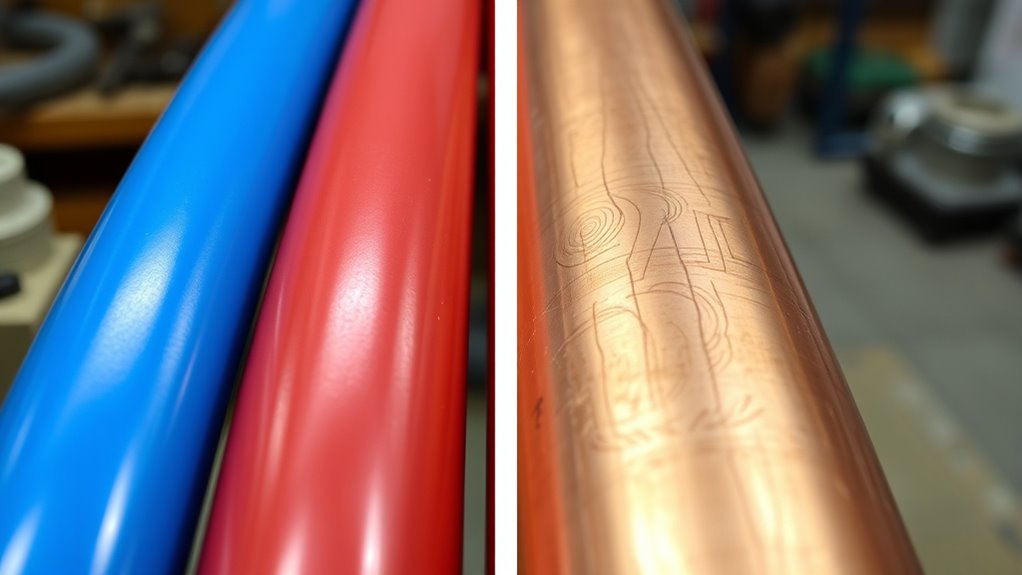
While keeping costs low might seem like the top priority, choosing PEX or copper pipes solely based on price can lead to problems down the line. Material cost is important, but it shouldn’t be your only consideration. PEX offers greater material flexibility, making it easier to install in tight spaces and around obstacles, while copper’s durability and longevity can justify a higher upfront investment. Additionally, aesthetic appeal matters—copper pipes often look cleaner and more traditional, which can enhance the overall look of your plumbing system. Focusing only on price might cause you to overlook these quality factors, resulting in issues like frequent repairs or less desirable visual outcomes later. Balancing cost with quality ensures you invest wisely in a plumbing solution that lasts, especially considering the material properties that influence performance and lifespan.
Overlooking Maintenance and Future Repair Needs
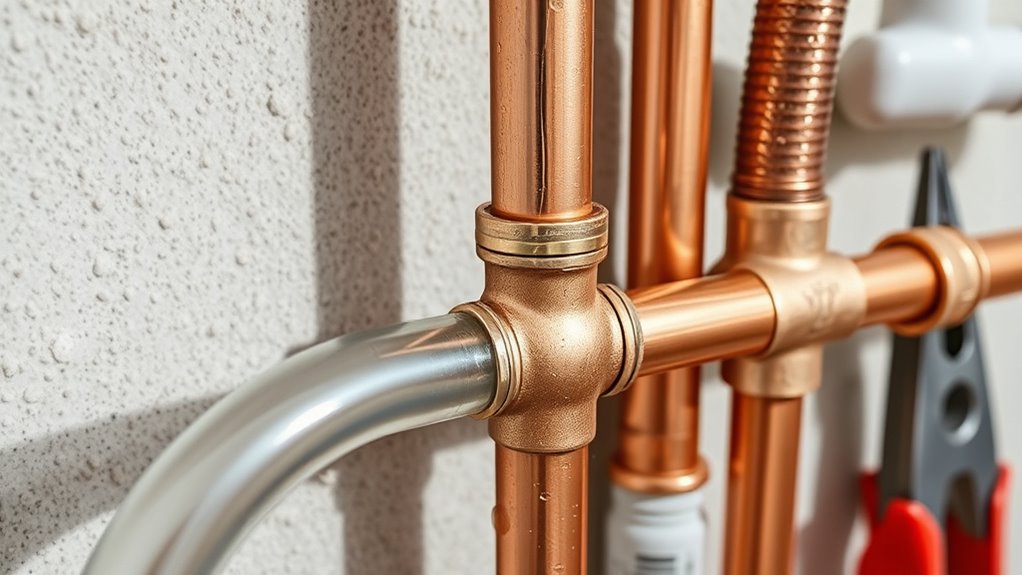
Neglecting to contemplate maintenance and future repair needs can lead to unexpected costs and inconvenience down the line. You should consider how pipe longevity and repair accessibility impact your system’s durability and ease of fixing issues. For example:
Ignoring maintenance needs can lead to costly repairs and system failures later on.
- Longer-lasting pipes reduce replacement frequency.
- Accessible connections simplify repairs and minimize disruption.
- Material durability influences long-term maintenance costs.
- Ease of access during installation affects future troubleshooting.
Frequently Asked Questions
How Does PEX Compare to Copper Regarding Water Quality Impact?
You’ll find that PEX generally maintains water clarity better than copper, as it doesn’t corrode or leach minerals over time. Copper pipes can cause mineral leaching, which might affect water taste and quality. With PEX, you’re less likely to experience these issues, making it a better choice for preserving clean, clear water. Just keep in mind that proper installation and maintenance are essential to maintaining water quality regardless of the material.
Are There Specific Tools Required for PEX Versus Copper Installation?
Did you know that using the right tools can reduce installation time by up to 50%? For PEX, you’ll need aPEX-specific crimp or clamp tools, while copper requires soldering kits or compression fittings. Fitting compatibility varies; PEX fittings often need specific crimp or clamp tools, whereas copper fittings may need a torch and solder. Always guarantee you have the proper tools to avoid leaks and ensure a secure, long-lasting connection.
What Are the Safety Considerations for DIY Plumbers Choosing Between PEX and Copper?
When choosing between PEX and copper, prioritize safety by using pipe insulation to prevent heat loss and protect against burns. Copper resists corrosion better, reducing leak risks, but make certain proper handling to avoid sharp edges. For PEX, avoid excessive bending to prevent damage. Always wear gloves and eye protection, and work in a well-ventilated area. These precautions help you install safely and ensure your plumbing lasts.
How Do PEX and Copper Perform in High-Pressure Water Systems?
In high-pressure water systems, PEX and copper perform differently. PEX offers excellent flexibility advantages, making it easier to install under high pressure without leaks. It handles pressure compatibility well, but always check manufacturer specs. Copper, on the other hand, is more rigid and can withstand higher pressure levels, making it ideal for demanding systems. Your choice depends on your specific pressure needs and installation environment.
Can PEX and Copper Be Used Together in a Single Plumbing Project?
Yes, you can use PEX and copper together in a single plumbing project, but you need to think about combination compatibility and material integration carefully. Use appropriate fittings designed for both materials to prevent leaks and corrosion. Make sure you follow local codes and manufacturer instructions. Properly shifting between PEX and copper helps maintain system integrity, so take your time to select the right connectors and techniques for a seamless, durable installation.
Conclusion
By avoiding these common mistakes, you ensure your plumbing project is both cost-effective and reliable. Think of it like choosing the right materials for a sturdy bridge—you want to take into account long-term durability over just initial costs. When you weigh factors like climate, regulations, and compatibility, you’re more likely to make informed decisions. Ultimately, investing a little extra effort now can save you headaches and money down the line, proving quality always pays off.
